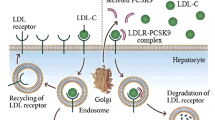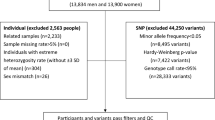Abstract
Purpose of Review
Lipoprotein (a) [Lp(a)] is a highly atherogenic lipoprotein species. A unique feature of Lp(a) is the strong genetic determination of its concentration. The LPA gene is responsible for up to 90% of the variance in Lp(a), but other genes also have an impact.
Recent Findings
Genome-wide associations studies indicate that the APOE gene, encoding apolipoprotein E (apoE), is the second most important locus modulating Lp(a) concentrations. Population studies clearly show that carriers of the apoE2 variant (ε2) display reduced Lp(a) levels, the lowest concentrations being observed in ε2/ε2 homozygotes. This genotype can lead predisposed adults to develop dysbetalipoproteinemia, a lipid disorder characterized by sharp elevations in cholesterol and triglycerides. However, dysbetalipoproteinemia does not significantly modulate circulating Lp(a). Mechanistically, apoE appears to impair the production but not the catabolism of Lp(a).
Summary
These observations underline the complexity of Lp(a) metabolism and provide key insights into the pathways governing Lp(a) synthesis and secretion.

Similar content being viewed by others
References
Papers of particular interest, published recently, have been highlighted as: • Of importance •• Of major importance
Kronenberg F, Utermann G. Lipoprotein(a): resurrected by genetics. J Intern Med. 2013;273:6–30.
Boffa MB, Koschinsky ML. Oxidized phospholipids as a unifying theory for lipoprotein(a) and cardiovascular disease. Nat Rev Cardiol. 2019;16:305–18.
Lambert G, Thedrez A, Croyal M, Ramin-Mangata S, Couret D, Diotel N, et al. The complexity of lipoprotein (a) lowering by PCSK9 monoclonal antibodies. Clin Sci. 2017;131:261–8.
McCormick SPA, Schneider WJ. Lipoprotein(a) catabolism: a case of multiple receptors. Pathology. 2019;51:155–64.
Kraft HG, Menzel HJ, Hoppichler F, Vogel W, Utermann G. Changes of genetic apolipoprotein phenotypes caused by liver transplantation. Implications for apolipoprotein synthesis. J Clin Invest. 1989;83:137–42.
White AL, Rainwater DL, Hixson JE, Estlack LE, Lanford RE. Intracellular processing of apo(a) in primary baboon hepatocytes. Chem Phys Lipids. 1994;67–68:123–33.
••. Zekavat SM, Ruotsalainen S, Handsaker RE, Alver M, Bloom J, Poterba T, et al. Deep coverage whole genome sequences and plasma lipoprotein(a) in individuals of European and African ancestries. Nat Commun. 2018;9:2606. The first whole-genome study demonstrating that genetic variations in LPA determine CVD risk. This study is also the first to demonstrates that APOE rs7412 (i.e., apoE2) is the second most significant locus after LPA associated with Lp(a) concentrations.
•. Hoekstra M, Chen HY, Rong J, Dufresne L, Yao J, Guo X, et al. Genome-wide association study highlights APOH as a novel locus for lipoprotein(a) levels-brief report. Arterioscler Thromb Vasc Biol. 2021;41:458–64. This study identified APOE and for the first time APOH loci as bona fide genetic determinants of Lp(a) plasma levels in a European population.
•. Said MA, Yeung MW, van de Vegte YJ, Benjamins JW, Dullaart RPF, Ruotsalainen S, et al. Genome-wide association study and identification of a protective missense variant on lipoprotein(a) concentration: protective missense variant on lipoprotein(a) concentration-brief report. Arterioscler Thromb Vasc Biol. 2021;41:1792–800. To date the most comprehensive GWAS establishing a causal role for Lp(a) in CVD independently of LDL-cholesterol levels.
Mack S, Coassin S, Rueedi R, Yousri NA, Seppälä I, Gieger C, et al. A genome-wide association meta-analysis on lipoprotein (a) concentrations adjusted for apolipoprotein (a) isoforms. J Lipid Res. 2017;58:1834–44.
Li J, Lange LA, Sabourin J, Duan Q, Valdar W, Willis MS, et al. Genome- and exome-wide association study of serum lipoprotein (a) in the Jackson Heart Study. J Hum Genet. 2015;60:755–61.
Boerwinkle E, Leffert CC, Lin J, Lackner C, Chiesa G, Hobbs HH. Apolipoprotein(a) gene accounts for greater than 90% of the variation in plasma lipoprotein(a) concentrations. J Clin Invest. 1992;90:52–60.
Surakka I, Horikoshi M, Mägi R, Sarin A-P, Mahajan A, Lagou V, et al. The impact of low-frequency and rare variants on lipid levels. Nat Genet. 2015;47:589–97.
Mahley RW. Apolipoprotein E: from cardiovascular disease to neurodegenerative disorders. J Mol Med. 2016;94:739–46.
Marais AD. Apolipoprotein E in lipoprotein metabolism, health and cardiovascular disease. Pathology. 2019;51:165–76.
Khalil YA, Rabès J-P, Boileau C, Varret M. APOE gene variants in primary dyslipidemia. Atherosclerosis. 2021;328:11–22.
Blom DJ, Byrnes P, Jones S, Marais AD. Non-denaturing polyacrylamide gradient gel electrophoresis for the diagnosis of dysbetalipoproteinemia. J Lipid Res. 2003;44:212–7.
de Knijff P, Kaptein A, Boomsma D, Princen HM, Frants RR, Havekes LM. Apolipoprotein E polymorphism affects plasma levels of lipoprotein(a). Atherosclerosis. 1991;90:169–74.
Ritter MM, Gewitsch J, Richter WO, Geiss HC, Wildner MW, Schwandt P. Apolipoprotein E polymorphism has no independent effect on plasma levels of lipoprotein(a). Atherosclerosis. 1997;131:243–8.
Anuurad E, Lu G, Rubin J, Pearson TA, Berglund L. ApoE genotype affects allele-specific apo[a] levels for large apo[a] sizes in African Americans: the Harlem-Basset Study. J Lipid Res. 2007;48:693–8.
Khan TA, Shah T, Prieto D, Zhang W, Price J, Fowkes GR, et al. Apolipoprotein E genotype, cardiovascular biomarkers and risk of stroke: systematic review and meta-analysis of 14,015 stroke cases and pooled analysis of primary biomarker data from up to 60,883 individuals. Int J Epidemiol. 2013;42:475–92.
•. Blanchard V, Chemello K, Hollstein T, Hong-Fong CC-, Schumann F, Grenkowitz T, et al. The size of apolipoprotein (a) is an independent determinant of the reduction in lipoprotein (a) induced by PCSK9 inhibitors. Cardiovasc Res. 2021;cvab247. This paper elegantly demonstrates that PCSK9 inhibitors are more effective at reducing Lp(a) levels in carriers of large apo(a) isoforms at any baseline Lp(a) concentration, regardless of APOE genotype.
Moriarty PM, Varvel SA, Gordts PLSM, McConnell JP, Tsimikas S. Lipoprotein(a) mass levels increase significantly according to APOE genotype: an analysis of 431 239 patients. Arterioscler Thromb Vasc Biol. 2017;37:580–8.
Kritharides L, Nordestgaard BG, Tybjærg-Hansen A, Kamstrup PR, Afzal S. Effect of APOE ε genotype on lipoprotein(a) and the associated risk of myocardial infarction and aortic valve stenosis. J Clin Endocrinol Metab. 2017;102:3390–9.
••. Rasmussen KL, Tybjærg-Hansen A, Nordestgaard BG, Frikke-Schmidt R. Plasma levels of apolipoprotein E, APOE genotype, and all-cause and cause-specific mortality in 105 949 individuals from a white general population cohort. Eur Heart J. 2019;40:2813–24. A very elegant study showing that among the most common APOE genotypes, carriers of the E4 variant are at increased risk of all cause, cardiovascular, and dementia-related mortality.
Lindahl G, Mailly F, Humphries S, Seed M. Apolipoprotein E phenotype and lipoprotein(a) in familial hypercholesterolaemia: implication for lipoprotein(a) metabolism. Clin Investig. 1994;72:631–8.
Blanchard V, Croyal M, Khantalin I, Ramin-Mangata S, Chemello K, Nativel B, et al. Reduced lipoprotein(a) associated with the apolipoprotein E2 genotype confers cardiovascular protection in familial hypercholesterolemia. JACC Basic Transl Sci. 2019;4:425–7.
Sandholzer C, Feussner G, Brunzell J, Utermann G. Distribution of apolipoprotein(a) in the plasma from patients with lipoprotein lipase deficiency and with type III hyperlipoproteinemia. No evidence for a triglyceride-rich precursor of lipoprotein(a). J Clin Invest. 1992;90:1958–65.
Feussner G, Feussner V, Ziegler R. Apolipoprotein (a) phenotypes and lipoprotein (a) concentrations in patients with type III hyperlipoproteinaemia. J Intern Med. 1994;235:425–30.
Krempler F, Kostner G, Bolzano K, Sandhofer F. Lipoprotein (a) is not a metabolic product of other lipoproteins containing apolipoprotein B. Biochim Biophys Acta. 1979;575:63–70.
•. Chemello K, Beeské S, Tran TTT, Blanchard V, Villard EF, Poirier B, et al. Lipoprotein(a) cellular uptake ex vivo and hepatic capture in vivo is insensitive to PCSK9 inhibition With Alirocumab. J Am Coll Cardiol Basic Trans Science. JACC: Basic to Translational Science; 2020;5:549–57. This study demonstrates that Lp(a) cellular uptake is similar in cells expressing or not expressing a functional LDL receptor. Futhermore, the modulation of LDLR function by the PCSK9 inhibitor alirocumab has no effect on the hepatic clearance of Lp(a) in a mouse model in which endogenous hepatocytes have been ablated and replaced by human ones.
••. Trinder M, DeCastro ML, Azizi H, Cermakova L, Jackson LM, Frohlich J, et al. Ascertainment bias in the association between elevated lipoprotein(a) and familial hypercholesterolemia. J Am Coll Cardiol. 2020;75:2682–93. This seminal study shows that FH does not cause elevated lipoprotein(a), but that elevated lipoprotein(a) increases the likelihood for an individual to be clinically diagnosed as FH.
Rader DJ, Cain W, Zech LA, Usher D, Brewer HB. Variation in lipoprotein(a) concentrations among individuals with the same apolipoprotein (a) isoform is determined by the rate of lipoprotein(a) production. J Clin Invest. 1993;91:443–7.
Rader DJ, Cain W, Ikewaki K, Talley G, Zech LA, Usher D, et al. The inverse association of plasma lipoprotein(a) concentrations with apolipoprotein(a) isoform size is not due to differences in Lp(a) catabolism but to differences in production rate. J Clin Invest. 1994;93:2758–63.
Ma L, Chan DC, Ooi EMM, Marcovina SM, Barrett PHR, Watts GF. Apolipoprotein(a) kinetics in statin-treated patients with elevated plasma lipoprotein(a) concentration. J Clin Endocrinol Metab. 2019;104:6247–55.
von Zychlinski A, Williams M, McCormick S, Kleffmann T. Absolute quantification of apolipoproteins and associated proteins on human plasma lipoproteins. J Proteomics. 2014;106:181–90.
Croyal M, Blanchard V, Ouguerram K, Chétiveaux M, Cabioch L, Moyon T, et al. VLDL (very-low-density lipoprotein)-Apo E (apolipoprotein E) may influence Lp(a) (lipoprotein [a]) synthesis or assembly. Arterioscler Thromb Vasc Biol. 2020;40:819–29.
Funding
KC and VB received a scholarship from the European Union (European Regional Development Fund INTERREG V) and the Région Réunion (Saint-Denis, Réunion, France). VB is a recipient of the Canadian Institutes for Health Research (CIHR) fellowship award. GL is supported by the Agence Nationale de la Recherche (Paris, France) Project Grant KRINGLE2 ANR-20-CE14-0009 and by La Fondation De France (FDF-00096274).
Author information
Authors and Affiliations
Corresponding author
Ethics declarations
Human/Animal Rights and Informed Consents
All reported studies/experiments with human or animal subjects performed by the authors have been previously published and complied with all applicable ethical standards (including the Helsinki declaration and its amendments, institutional/national research committee standards, and international/national/institutional guidelines).
Competing Interests
GL reports research funding and honoraria from Nyrada Inc. GL is a member of the Scientific Advisory board of Nyrada Inc. ADM reports research funding and honoraria from the University of Utrecht. ADM also reports other for the Lipid and Atherosclerosis Society of Southern Africa. KC, VB, and DJB have no relationships to disclose.
Additional information
Publisher's Note
Springer Nature remains neutral with regard to jurisdictional claims in published maps and institutional affiliations.
This article is part of the Topical Collection on Cardiometabolic Disease and Treatment
Rights and permissions
About this article
Cite this article
Chemello, K., Blom, D.J., Marais, A.D. et al. Genetic and Mechanistic Insights into the Modulation of Circulating Lipoprotein (a) Concentration by Apolipoprotein E Isoforms. Curr Atheroscler Rep 24, 399–405 (2022). https://doi.org/10.1007/s11883-022-01016-8
Accepted:
Published:
Issue Date:
DOI: https://doi.org/10.1007/s11883-022-01016-8




